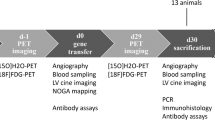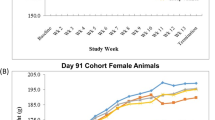Abstract
After the study in vitro and in rats, we assessed further the effects and safety of local angiogen therapy using intramyocardial delivery of an adenovirus carrying hepatocyte growth factor gene (Ad-HGF) in a canine ischemia model. The angiogenic activity of Ad-HGF was evaluated from three aspects. First, the augmentation of collateral vessel development was assessed by angiography 30 d after surgery. The results showed that the density of collateral vessels in treated group was higher than that of control group. Secondly, infarct size was evaluated by TTC staining and image analysis. The results showed that the infarct size of treated group was smaller than that of control group. Thirdly, the myocardial regional blood flow was determined by the method of colored microspheres. The results showed that the blood flow recovered to the level before ligation in treated group, but that of the control group was lower than normal level. In addition, during the study of chronic toxicity, we tested the anti-adenovirus antibodies by neutralization method. The antibodies yielded after the fourth injection decreased slowly from peak level and disappeared 12 weeks after drug withdrawal. Overall, Ad-HGF can promote angiogenesis in ischemic myocardium and reduce infarct size. So this method may be considered as a therapeutic angiogenesis induction strategy for ischemic disease including myocardial infarction and peripheral artery disease. At the same time, Ad-HGF could induce the yield of anti-adenovirus antibodies to neutralize adenovirus, which may be the mechanism of adenovirus clearance.
Similar content being viewed by others
References
Tio, R. A., Tkebuchava, T., Scheuermann, T. H. et al., Intramyocardial gene therapy with naked DNA encoding vascular endothelial growth factor improves collateral flow to ischemic myocardium, Hum. Gene. Ther., 1999; 10(18): 2953–2960.
Hanawala, M. D., Horowitz, J. R., Esalof, D. et al., VEGF improves myocardial blood flow but produces EDRF-mediated hypotension in porcine hearts, J. Surg. Res., 1996; 63(1): 77–82.
Carcia-Martinez, C., Opolon, R., Trochon, V. et al., Angiogenesis induced in muscle by a recombinant adenovirus expressing functional isoforms of basic fibroblast growth factor, Gene Ther., 1999, 6(7): 1210–1221.
Stuart, K. A., Riordan, S. M., Lidder, S. et al., Hepatocyte growth factor /scatter factor-induced intracellular signaling, Int. J. Exp. Pathol., 2000; 81(1): 17–30.
Vargas, G. A., Hoeflich, A., Jehle, P. M., Hepatocyte growth factor in renal failure: Promise and reality, Kidney Int., 2000, 57(4): 1426–1436.
Moroshita, R., Aoki, M., Nakamura, S. et al., Gene therapy for cardiovascular disease using hepatocyte growth factor, Ann. N. Y. Acad, Sci., 2000, 902: 369–376.
Stella, M. C., Comoglio, P. M., HGF: A multifunctional growth factor controlling cell scattering, Int. J. Biochem. Cell Biol., 1999, 31(12): 1357–1362.
Wu Danli, Zhang Yourong, Lao Miaofen et al., Therapeutic angiogenesis induced by human hepatocyte growth factor (HGF) gene in rat myocardial ischemia models, Chinese Science Bulletin, 2003, 48(3): 273–276.
Tanaka, M., Brooks, S. E., Richard, V. J. et al., Effect of anti-CD18 antibody on myocardial neutrophil accumulation and infarct size after 90 minutes of ischemia and 3 hours of reperfusion in dogs, Circulation, 1993, 87(2): 526–535.
Kowallik, P., Schulz, R., Guth, B. D. et al., Measurement of regional myocardial blood flow with multiple colored microspheres, Circulation, 1991, 83(3): 974–982.
Yasuda, S., Goto, Y., Baba, T. et al., Enhanced secretion of cardiac hepatocyte growth factor from an infarct region is associated with less severe ventricular enlargement and improved cardiac function, J. Am. Coll. Cardiol., 2000, 36(1): 115–121.
Nakamura, T., Mizuno, S., Matsumoto, K. et al., Myocardial protection from ischemia/reperfusion injury by endogenous and exogenous HGF, J. Clin. Invest., 2000, 106(12): 1511–1519.
Simons, M., Annex, B., A double-blind, placebo-controlled, dose escalation phase I study to assess the safety and effects of AMG0001 in patients with ischemic heart disease (IHD) not amenable to coronary artery bypass graft (CABG) or percutaneous coronary intervention (PCI), Recombinant DNA Advisory Committee, 2002,: 20–23.
Lee, L. Y., Patel, S. R., Hackett, N. R. et al., Focal angiogen therapy using intramyocardial delivery of an adenovirus vector coding for vascular endothelial growth factor 121, Ann. Thorac. Surg., 2000, 69(1): 14–24.
Author information
Authors and Affiliations
About this article
Cite this article
Wu, D., Zhang, Y., Lao, M. et al. Therapeutic induction of angiogenesis by direct myocardial administration of an adenovirus vector encoding human hepatocyte growth factor gene and its safety. Chin.Sci.Bull. 49, 1464–1469 (2004). https://doi.org/10.1360/04wc0161
Received:
Accepted:
Issue Date:
DOI: https://doi.org/10.1360/04wc0161




